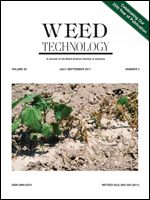Cuphea is a new crop of temperate regions that produces seed oil that can substitute for imported coconut and palm kernel oils. Only four herbicides are known to be tolerated by cuphea to date. More herbicides, especially POST products, are needed for continued commercialization. In Minnesota and North Dakota, where cuphea currently is grown, greater control of Canada thistle and biennial wormwood is needed in cuphea. Because clopyralid is effective on both of these species, it was tested at rates ranging from about 25 to 850 g ae ha−1 in greenhouse and field trials. Visual assessment of injury, height, growth, and seed yield of cuphea were not reduced significantly in field-grown plants when clopyralid was applied at rates up to 400 g ae ha−1. Thus, at the rate commonly used in other crops, 200 g ae ha−1, clopyralid can be applied safely to cuphea.
Nomenclature: Clopyralid; biennial wormwood, Artemisia biennis Willd.; Canada thistle, Cirsium arvense (L.) Scop.; cuphea, Cuphea viscosissima Jacq. × C. lanceolata W.T. Aiton.





